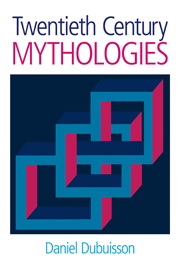Book contents
- Frontmatter
- Epigraph
- Contents
- Foreword by Professor Robert A. Segal
- Preface
- Abbreviations
- Introduction: History and comparative epistemology
- Part I Georges Dumézil, or Society
- 1 The Indo-European background
- 2 The first comparative mythologies
- 3 Durkheim, Mauss, Bourdieu, and Dumézil
- 4 The 1950s: a reorientation
- 5 Comparative and structural evidence
- 6 The new comparative mythology
- Addendum I Theory, history, and the limits of Dumézil's comparativism
- Addendum II Does a Dumézilian theory of religion exist?
- Part II Claude Lévi-Strauss, or the Mind
- Part III Mircea Eliade, or the Sacred
- Conclusion: Modern theories of myth and the history of Western thought
- Bibliography
- Index
4 - The 1950s: a reorientation
from Part I - Georges Dumézil, or Society
- Frontmatter
- Epigraph
- Contents
- Foreword by Professor Robert A. Segal
- Preface
- Abbreviations
- Introduction: History and comparative epistemology
- Part I Georges Dumézil, or Society
- 1 The Indo-European background
- 2 The first comparative mythologies
- 3 Durkheim, Mauss, Bourdieu, and Dumézil
- 4 The 1950s: a reorientation
- 5 Comparative and structural evidence
- 6 The new comparative mythology
- Addendum I Theory, history, and the limits of Dumézil's comparativism
- Addendum II Does a Dumézilian theory of religion exist?
- Part II Claude Lévi-Strauss, or the Mind
- Part III Mircea Eliade, or the Sacred
- Conclusion: Modern theories of myth and the history of Western thought
- Bibliography
- Index
Summary
From 1941 Dumézil expanded his project by adding the three legendary tribes of Roman synoikismos: the Ramnes (companions of Romulus), the Luceres (companions of the Etruscan warrior Lucumon and allies of Romulus against the wealthy subjects of Titius Tatius), and the Tities or Titienses. He had refrained from mentioning these tribes in his 1938 article “La préhistoire des flamines majeurs”, in which he had established for the first time the correspondence, by virtue of their common prehistoric ideology, between the Vedic social classes and the major flamens of Rome (Jupiter, Mars, and Quirinus). In the three Roman tribes he now recognized mythic equivalents of real functional classes, for this reason alone seeing them as comparable to their Indo-Iranian or Celtic homologues:
Thus we will be led to ask if other vestiges of this organization into functional classes continue to exist, in addition to the three flamens, its “sacerdotal reflection”; and notably if the three primitive tribes that the ancients hardly knew how to interpret any longer were not in fact an example of the functional-class principle. We believe that verification of this is possible, by means of sufficient philological rigour.
(JMQ1, 34)In the face of the difficulties raised by this thesis, which was unconfirmed by any historical or archaeological document, Dumézil tried to make do with an artificial solution too ingenious to be convincing: he conceded that only the aristocracy had needed to be divided into “three functional groups,” whereas the rest, the undifferentiated mass of Roman people, had not required any exclusive, lasting specialization (JMQ4, 160, 165; Héritage, 189, 221).
- Type
- Chapter
- Information
- Twentieth Century Mythologies , pp. 43 - 52Publisher: Acumen PublishingPrint publication year: 2006

